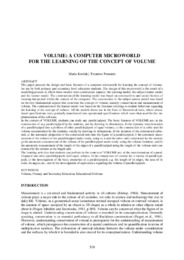Volume: a computer microworld For the learning of the concept of volume
Abstract
This paper presents the design and basic features of a computer microworld for learning the concept of volume, for use by both primary and secondary level education students. The design of this microworld is the result of a modelling process in which three models were constructed, namely: the learning model, the subject matter model and the learner model. The construction of the learning model was based on constructivist and social theories of learning interpreted within the context of the computer. The construction of the subject matter model was based on the two fundamental aspects that constitute the concept of volume, namely: conservation and measurement of volume. The construction of the learner model was based on the literature referring to student behaviour regarding the learning of the concept of volume. All the models above are in the form of hierarchical trees, where educa-tional specifications were gradually transformed into operational specifications which were then used for the im-plementation of the software.
In the context of VOLUME, students can study any parallelepiped. The basic features of VOLUME are: a) the construction of any parallelepiped by the students, just by drawing its dimensions, b) the dynamic transformation of a parallelepiped into a plethora of other parallelepipeds of equal volume, c) the construction of a cubic-unit for volume-measurement by the students, simply by drawing its dimensions, d) the iteration of the constructed cubic-unit, e) the automatic projection of the constructed unit onto the figure of a parallelepiped, f) the automatic meas-urement of the volume of the parallelepiped under study, using as a unit the cubic-unit constructed by the student, g) the automatic measurement of the volume of the parallelepiped under study, using the volume formulae, and h) the automatic measurement of the length of the edges of a parallelepiped using the length of the volume-unit con-structed by the student as the length unit. The learning activities that students can perform in the context of VOLUME are: a) the transformation of a paral-lelepiped into other parallelepipeds with equal volume, b) the comparison of volume for a variety of parallelepi-peds, c) the investigation of the basic properties of a parallelepiped, e.g. the length of its edges, the area of its sides, its angles etc., and d) the investigation of equivalence regarding the volume of parallelepipeds.
